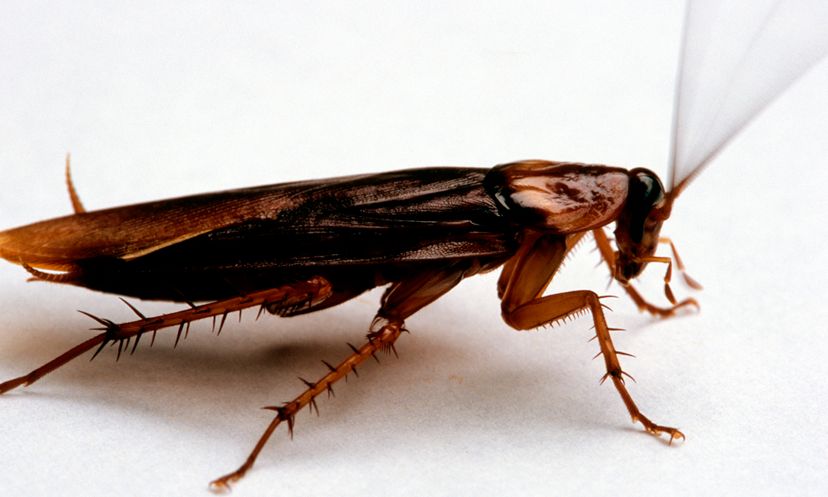
About This Quiz
The cockroach is one species of insect that has been around for millions of years. This prehistoric insect is also one of the most feared and dreaded invaders of our homes and businesses. Cockroaches have a bad reputation because of their tendency to seek food and shelter in our homes, but poor housekeeping is often the reason for infestations. Take our quiz to learn more about these annoying insects and how best to keep them out of your home.Entomologists estimate that there are between 5 and 10 million species of insects on Earth and we know that some of them are really scary. However, if asked which insect they hate the most, many people would have no trouble choosing the cockroach.
Because roaches eat garbage and waste, they can spread bacteria like Salmonella and Shigella from place to place. The proteins contained in cockroach saliva and waste can cause allergies and aggravate asthma symptoms in humans.
Although roaches are good at hiding, the main reason that most people fail to detect them until it is too late is because they are nocturnal and only move around when a room is dark. Most often the first time you notice a roach is if you switch on a light in the middle of the night and you surprise each other.
Advertisement
The American and German roaches are among the biggest and are responsible for most infestations in North America. Most people think that roaches cannot fly, but many of them can for short distances.
There are some 4,000 roach species in the world, but only a few spices actually plague homes and businesses. In many parts of the world, only the German cockroach is responsible for most infestations.
Many cockroaches live in warm, tropical areas and feed only on decaying wood and leaves. They help break down this organic debris; in the process, they fill an important role in our ecosystem by adding nutrients to the soil through their waste.
Advertisement
Experts consider that cockroaches have thrived for some 320 million years. That is amazing, considering that dinosaurs became extinct 65 million years ago and roaches survived what ever killed off the dinosaurs.
The roach's head houses its brain, but much of its nervous system activity takes place in ganglia throughout their bodies. This is one reason why a headless roach can live for more than a week.
Roaches draw air through spiracles, or holes in their sides and tubes called tracheae, which deliver oxygen from the spiracles to organs and tissues. This is the other reason a headless roach can live so long and when a headless roach finally dies, it dies of thirst.
Advertisement
Movable antennae, also known as antennal flagella, allow roaches to feel and smell. Although the antennae look like threads, they are really made of lots of tiny, hair-covered segments.
The very long metathoracic legs are the roach's back legs, and they move the roach forward, in fact by using these legs, a roach can move about 50 body lengths in a second. A human moving that quickly would be going 200 miles per hour (322 kph)!
A roach can rise up on its back legs for increased speed, with the force of moving air holding it up as it speeds away. A roach will also use its short front legs as brakes to help it weave, turn or stop as it runs with its middle legs moving back and forth to regulate speed.
Advertisement
The front and back legs on one side move at the same time as the middle leg on the other side. Each leg can also move up and down like a pogo stick or back and forth like a pendulum.
The segmented tarsus acts like an ankle, a foot, and helps a roach climb walls or to walk upside down on ceilings. When a roach runs upside down on a ceiling, it takes longer steps in an attempt not to fall down.
Some species of wasp use cockroaches as incubators for their eggs. A female wasp will sting a roach or remove its antennae to disable it; she will then lay her eggs inside where they will grow until they hatch.
Advertisement
The common house centipede eats cockroach nymphs as well as ants and other creepy crawlers. They are not a bad thing to have around if you can tolerate them without getting shivers.
A roach's digestive system has a few extras that let it eat cellulose or other tough materials, like the crop that holds swallowed food until a toothy section of the digestive tract, called the proventriculus, can pulverize it. Sacs called the gastric cacea hold enzymes and microbes that continue to digest the food before it reaches the midgut for absorption.
Two segmented cerci lie on the exterior of the lower part of a roach's abdomen and they can behave as sensory organs. A nerve inside the roach allows it to detect air movement around its cerci, which signals an object moving quickly toward them.
Advertisement
Most young roaches grow in eggs within a sac attached to the outside of a mother’s abdomen. Many mothers drop or hide the egg sac just before the eggs hatch and may roaches care for their offspring after they hatch.
A German cockroach and her young can produce 300,000 more roaches in one year. An American cockroach and her young can produce a comparatively small 800 new roaches per year.